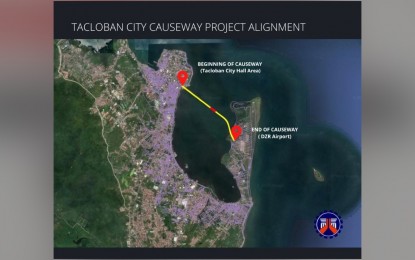
The Tacloban causeway project. (DPWH photo)
TACLOBAN CITY – The causeway project that will connect the city hall to the airport here will start before the end of the year with an initial PHP1 billion funding.
The first phase of the project is currently advertised, and bidding will go in early October.
Civil works will begin within the fourth quarter of the year, according to Noel Nadera, senior engineer of the Department of Public Works and Highways (DPWH) regional planning and design division, on Tuesday.
“Our target is to finish the project within three years since there are no issues on right of way acquisitions. We will still come up with work schedule in the next years since our focus was on the scope of work for the PHP1 billion allocation,” Nadera said in an interview.
The 2022 allotment will finance the construction of 586 meters stretch of the causeway.
Funding for the entire PHP3.46 billion project will be included in future appropriations.
The first of its kind in Eastern Visayas, the causeway will serve as an alternate route for motorists from the city’s commercial district going to the airport, reducing distance, travel time, and vehicle operation costs.
This project involves the construction of a four-lane road embankment that spans approximately up to 2.55 kilometers with a bridge that stretches to 180 meters. It will also feature separate bike lanes, concrete canals, sidewalks, as well as wave deflectors on both sides.
Environmental group Save Kankabatok Advocacy has expressed opposition to the project saying the causeway would block the passage of seawater from and to Cancabato Bay affecting the ecosystem.
The group refuted the claims of DPWH and other officials that Cancabato Bay is no longer a rich fishing ground due to massive pollution.
“We have been raising awareness to the public on the effects of the causeway project to the Cancabato bay ecosystem and to the communities around it. The bay is not dead (as opposed to the claim in the Comprehensive Land Use Plans) and that it is much alive and is giving various ecosystem services direct or indirectly to the communities around it or far from it,” the advocacy group said.
Nadera said the180-meter bridge and five box culverts with three meters in width and height each would allow free water flow.
“There are no more hindrances since the project has been endorsed by the local government and concerned national government agencies,” the DPWH officials added.
The DPWH assured that the project was designed to withstand strong typhoons and high humidity and protect nearby communities from big waves.
The main core of the structure is common borrow (filling materials) reinforced with high strength geotextile laid at every two-meter fill.
The hydraulic geotextile tubes will be placed on both sides to contain the embankment and to add stability to the structure.
The toe and side slopes of the embankment are protected by layers of armored rocks.
Aside from being an alternative highway, the causeway will also shield communities from destructive waves.
The original plan was to build a tide embankment structure, but it was discontinued due to strong opposition by several property owners in the city’s populated coastal communities. (PNA)
